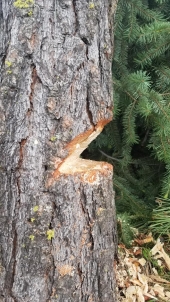posted 5 years ago
Post 3...
We started with native overgrown forested areas... about 45 out of 68 acres. we didn’t really have to plant a forest so much as clear some areas back to stone walls, clear an old road, clear the old fields... along the way create a more varied habitats: old growth forest, regenerated areas, deer areas, snowshoe hare and lynx, fisher and mink, margin areas. Deer are very prevalent as are bear, coyote, fox, owls, bats, frogs, etc. so our hugel work is merely returning the brushed out material back into the forest in a way that doesn’t cause a fire hazard. We do leave some downed trees and the occasional wolf tree for habitat. We just had so many overgrown areas, we had to figure a better way. The forested hugels get native grass seeded, or clover, or even field peas or buckwheat. Usually a mix. Overtime the mound sections will have witch hazel, bear berry, aronia depending on high up on the ridge they are. Some already have teaberry (wintergreen) the shady areas or alpine strawberries in sunnier spots.





